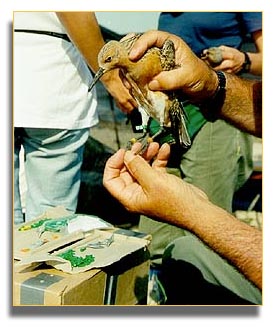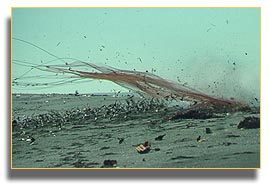

Read more about WASA's inaugural project, the International Shorebird Banding Project.
 |
| Red Knot captured by ISBP tean in Delaware Bay is colour banded before release. |
| Foto:M.Dennison |
The primary goals of this project are to:
The project is working with local scientists, wildlife managers, students and volunteers in four main locations on the flyway:
In the Canadian Arctic, a team has spent last two summers searching for breeding Red Knots in and around Southampton Island, Northwest Territories. They recently reported finding a colour-banded Knot at a nest. Read more....
In Delaware Bay, United States, project members and volunteers have been colour banding shorebirds on both sides of the bay in May and June each year since 1995.
In Brazil, expeditions have been to the estuaries in southern Brazil which are important stopovers for Red Knots and Turnstones in particular.
In Argentina, the project works in collaboration with the Fundación Inalafquen to study shorebirds. Two key areas are Tierra del Fuego, the main wintering area, and San Antonio Oeste which is an important early stopover for Red Knots and Ruddy Turnstones migrating north in March.
 |
| Cannon net firing over resting shorebirds at Rio Grande, southern Argentina |
| Foto:M.K.Peck |
Captured birds are banded with a uniquely numbered metal band. Study species are also banded with colour flags and bands. Read more....
In addition to banding, birds are measured and weighed,
and scored for wing moult and body condition.
The following Institutions have participated in the project:
The project has been operated by funds and support in kind from the following groups and institutions:
The project leaders are:
Professor Allan J. Baker
Center for Biodiversity and Conservation Biology
Royal Ontario Museum
100 Queen's Park
Toronto, Canada
M5S 2C6
Patricia M. González
Fundación Inalafquen
CC 84 - 8520
San Antonio Oeste
Río Negro
Argentina
Email: patriciag@canaldig.com.ar
| [ Page d'accueil ] | [ Cartes ] | [ Entrée des données ] | [ Education ] | [ Contactez nous ] |
© 2000 Association des oiseaux du littoral de l'Atlantique ouest